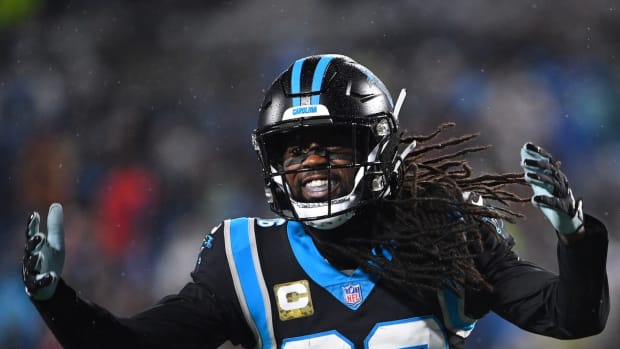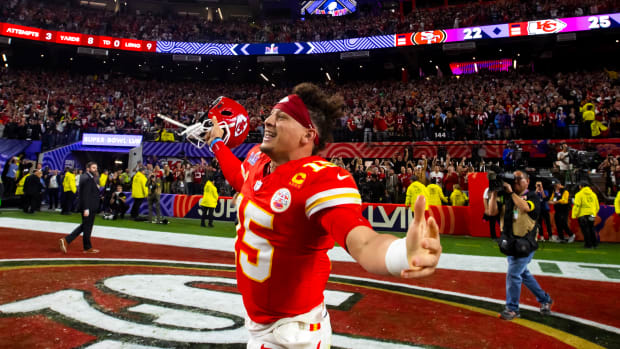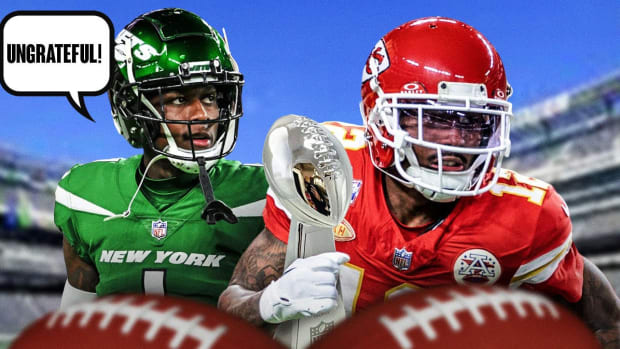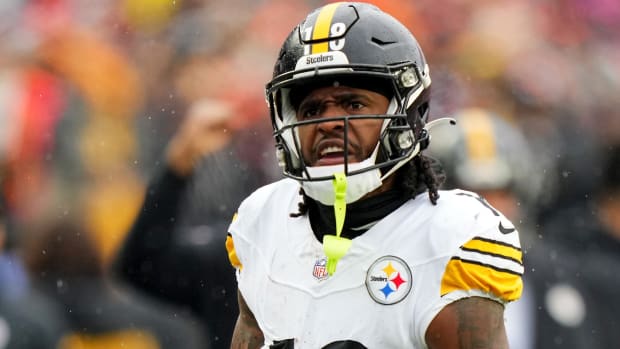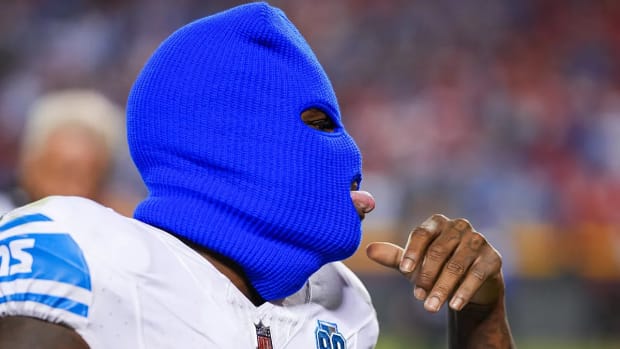Answering the Crucial Question for Each Top Quarterback in the 2018 NFL Draft
It’s an unprecedented draft when it comes to the quarterback position, with possibly four passers being drafted in the first five picks, and maybe five or six going in the first round. But maybe the most shocking of all? There’s no clear front-runner.
Each quarterback comes with a significant, complex question. Examining those questions takes us to the heart of great NFL quarterbacking philosophizing.
Sam Darnold, USC
What do you make of out-of-structure plays?
Darnold’s best work comes when he’s outside of the pocket throwing on the move—and this is done by improvisation as often as by design. It’s great when it works, but it can make for an inconsistent offense when it’s part of a quarterback’s foundation. Take the Seahawks’ 2017 season for example: For the first two and a half months, Russell Wilson was an MVP candidate. But the last six weeks, Seattle averaged 268 yards of total offense a game, which ranked 29th over that span. To no one’s surprise, the Seahawks lost three of their last four games and missed the playoffs.
The blame isn’t entirely on the quarterback, but when an offense is accustomed to him running around, it becomes difficult to steady the boat once it starts rocking. Players amend their fundamentals to accommodate the sandlot style QB. Unfortunately, these amendments aren’t synchronized like a structured play. Receiver A amends things one way, Receiver B another. The amendments are fundamentally flawed (that’s why they weren’t drawn into the play originally), so the coach has trouble evaluating his receivers and concocting new plays. Small problems build upon small problems, creating bigger problems.
Sandlot quarterbacking shouldn’t be fully discouraged, though, because it also has the ability to make something out of nothing. That’s where Wilson can be brilliant, and it’s also where teams can get smitten with Darnold. He’s not the runner that Wilson is, but as an on-the-move thrower, he exhibits many of Wilson’s traits—and some teams will think Darnold can potentially be of Wilson’s ilk.
Darnold gets a boost from being five inches taller and 15 pounds heavier than Wilson, meaning he has no trouble seeing from the pocket. As a coach’s thinking goes, he can be taught to hang in there on traditional dropbacks, using his mobility only as a last resort. When you put it that way—a Russell Wilson-type mover with the size to stay in the pocket and see the whole field—Darnold becomes an easy first overall pick.
But then factor in the decision-making. Darnold threw 13 interceptions in 14 games last year at USC, and almost every game there were other risky plays that put his coaches’ hearts in their throats. Bad decisions usually get punished by NFL defenses. Say Darnold is the next Russell Wilson, only he’s promised to have six more turnovers a year than Wilson. Do you still take him first overall? What if it’s eight more turnovers? Ten?
What’s concerning is if Darnold’s mistakes start piling up, it’s easy to envision him falling into the trap of using his legs far too often. For a pro quarterback, mobility can be an asset, but it can’t be your foundation. What coaches must ultimately decide is, Can Darnold use his legs appropriately in our system, and can our system create more appropriate chances for those legs?
Josh Rosen, UCLA
How do you take a quarterback’s personality into consideration?
There’s no question that Rosen, stylistically, is the most pro-ready QB in this draft. He is the easiest to envision in the NFL, with his game predicated on reading the field and making timing-and-rhythm throws—both things that usually translate well to the highly structured pro game. Rosen’s arm is unremarkable but strong enough. He’s not Kurt Warner, but his precision accuracy is in the plus column; with some improvements, it could propel him to stardom.
The concerns with Rosen are personal. He can be strikingly honest—in his interview with Bleacher Report’s Matt Hays published last August, he said:
“Look, football and school don’t go together. They just don’t. Trying to do both is like trying to do two full-time jobs. There are guys who have no business being in school, but they’re here because this is the path to the NFL. There’s no other way. Then there’s the other side that says raise the SAT eligibility requirements. OK, raise the SAT requirement at Alabama and see what kind of team they have. You lose athletes and then the product on the field suffers.”
Some in the NFL will like that he’s smart and outspoken, while others will say he’s too smart for his own good. There’s a fine line between intelligent honesty and obnoxious contrarianism. Many NFL people don’t want players who even toe it, especially at quarterback.
Rosen’s UCLA coach, Jim Mora, recently told The MMQB’s Peter King, “[Josh] needs to be challenged intellectually so he doesn’t get bored…If you can hold his concentration level and focus only on football for a few years, he will set the world on fire.”
Let’s say Rosen is as smart but also as biting as he sometimes appears. Does that matter? You heard discouraging stories about Jay Cutler over the years, but Cutler still wound up starting 153 games. He lost just over half of them, but that was due to on-field factors like erratic mechanics and decision-making. Of course, you could always argue that if Cutler weren’t so prickly, he would have been more coachable and amenable to correcting his flaws. The problem is we don’t know this for sure, we’re only guessing. Even those who were around Cutler daily can only guess here—it’s armchair psychology stuff.
Plus, there are other examples that muddy the picture. Ben Roethlisberger wasn’t exactly beloved by teammates early in his career. He had to mature, but the Steelers still had a lot of success before he did.
Rosen isn’t Cutler or Roethlisberger. Which gets to the heart of the problem with evaluating quarterbacks not as players, but as people: each is different. And in what ways those differences manifest on the field is anyone’s guess. An unhappy quarterback disenchanted with life off the field might stink it up on Sunday because his life is miserable and full of distractions. Or, he could light it up on Sunday because gameday offers a break from the misery.
Also keep in mind that all of a QB’s personality factors can be impacted by the city he lives in, the players he’s around and the coaches he plays for. Every team believes their culture is the one that can work for the player, but none actually know this. Plus, cultures change. By the time Rosen completes his rookie contract, statistics say that more than 40 of his original teammates will be gone and he’ll be on a second, or even third, coaching staff. And so you have more guesswork. That’s why QBs with personality questions can slide down boards: there’s simply too much guesswork.
Josh Allen, Wyoming
Can you expect a QB’s accuracy to improve once he goes pro?
Accuracy is like comedic timing or singing: it can be polished and honed, but not taught and created. No one questions Allen’s arm strength, which is off the charts in terms of distance and, much more importantly, velocity. The question is whether Allen’s footwork and mechanics can improve enough for that arm to consistently hit the target.
In many respects, Allen compares to Cam Newton. Mechanically, they’re different styles of throwers, but their results are similar. Newton is a first-class fastball pitcher who puts a few well outside the strike zone each week. The Panthers have worked around this, though at times it’s been too much to overcome. The tradeoff is you get some completions, particularly down the seams, that you wouldn’t get with, say, a Kirk Cousins.
Allen also compares to Newton as a runner. Allen isn’t quite as swift or light-footed, but he’s faster than he looks and, at 240 pounds, he’s theoretically built to endure up to 10 carries a game. Many of Wyoming’s multi-option gap scheme run concepts (think pull-blockers with QB reads) can be compared to Carolina’s. That changes your entire rushing attack.
Notably, Allen can be a better on-the-move thrower than Newton. Designed rollouts are not big in Carolina’s offense, but they were in Wyoming’s. Allen was especially effective on designed movement to his right, and with that arm, an intensive refinement of footwork and mechanics could make him effective going left.
It’s up to the Browns to determine how much of that refinement can occur while Allen adaps to the NFL. If the answer is not much, they then must determine whether they can live with Allen’s inevitable extreme ups and downs. Another way to look at this: If the Panthers re-did the 2011 draft knowing what they know now, would they still take Newton with the No. 1 pick? (Maybe it helps Allen that there is no projected Von Miller, Patrick Peterson, Julio Jones, Tyron Smith or J.J. Watt in this draft.)
Baker Mayfield, Oklahoma
How much can you boost a player’s strengths and minimize his weaknesses?
At the core, this is what coaching and the draft evaluation process are all about. Mayfield has some of that Sam Darnold tendency to run around and make plays, which, along with his 6' 1", 210-pound size, is what’s largely behind those irksome Johnny Manziel comparisons. The difference, though, is Mayfield is not dependent on this approach. His best work at Oklahoma came when he played within the timing and rhythm of the offensive design. The Sooners’ system, at times, presented Mayfield with gimme completions that do little to help forecast his professional outlook. But it was an expansive system that also included some NFL concepts. When Mayfield played in rhythm on these, he was excellent.
The concern is whether Mayfield can do this regularly. His discipline often vanished when he was blitzed, and his fundamentals then became grossly flawed. He could get away with it in college, where he was more dynamic than many opponents. But in the NFL, his lack of size and top-end speed will be punished. The idea with every player is to boost strengths and minimize weaknesses, but with Mayfield it’s more important because he may not have the physical tools (or certainly the size) to overcome his weaknesses should they grow even a little.
Which leads us to Part B of this question: if Mayfield’s weaknesses grow, can you tweak your offense to work around it? Teams who believe in Mayfield’s playmaking will say yes. Teams that see his success linked almost exclusively to timing and rhythm passing will say no.
• Baker Mayfield: The Scouting Report—Robert Klemko’s series on the 2018 draft’s most fascinating prospect
Lamar Jackson, Louisville
Can you mold a traditional college style superstar QB for the pro game?
Prior to last year, the answer may have been no. But then Deshaun Watson happened. The Texans brilliantly adjusted their system—on the fly, no less—to capitalize on Watson’s mobility, and Watson, to his immense credit, became more willing each week to play within the pocket, refusing to use his legs as a crutch. That’s imperative for successful long-term pro quarterbacking.
This near-perfect meeting in the middle between team and quarterback is uncommon, but not enough to prevent a team this year from saying, Hey, if it worked for Houston with Watson, why can’t it work for us with Jackson? Like Watson, Jackson has a sense for touch passing, and he’s willing to let it rip downfield. Or, at least he was when Louisville’s offense, which featured pro concepts, called for it. Decisiveness can make a QB outperform his arm strength.
It should be noted, in terms of an NFL translation, Jackson is a more extreme version of what Watson was coming out of Clemson. Jackson’s tendency to break down and leave the pocket was greater than Watson’s because his mobility was more electrifying. Jackson presents the rare opportunity to appropriately invoke memories of Michael Vick highlight reel runs. That’s notable for his development, but as we’ve learned time and again, including with Vick, running must be something an NFL QB can call on without relying on.
Lamar Jackson, His Mother, and the Plan They’ve Always Had
Mason Rudolph, Oklahoma State
Should you reach for a quarterback?
First things first: Rudolph is not of first-round caliber. His physical tools are not special enough to overcome his deficient pocket poise. He was prone to mistakes and mechanical breakdowns when the pocket muddied in college. In the NFL, those pockets muddy quicker and more often. If you can’t play from them, you’ll never be more than an up-and-down starter, and that’s assuming you’re supremely gifted. Guys with so-so toolkits who struggle in bad pockets become fringe backups or insurance salesmen.
It’s uncommon for a player’s pocket poise to improve once he goes pro, at least when you’re starting with little poise to begin with. However, it’s not technically impossible. Some teams will see Rudolph’s attributes more favorably and believe that, in the right system, he could effectively run an NFL offense. What those teams must determine is whether Rudolph can improve significantly in muddied pockets, and if so, how big of a bet should they place on it? A quarterback can be so hard to find that, to some teams, it’s worth risking a first-round pick even on one who has only a small chance at panning out. Because if he DOES pan out, the payoff is huge.

































